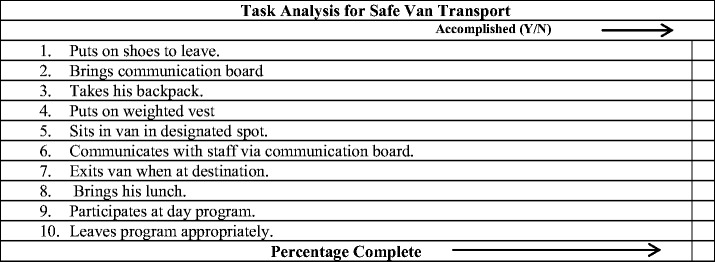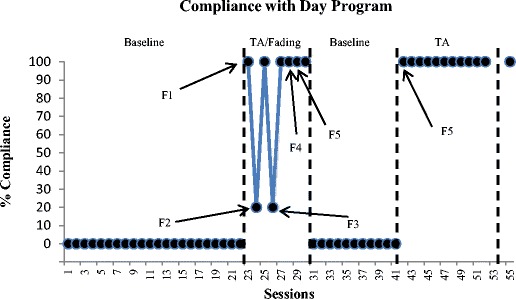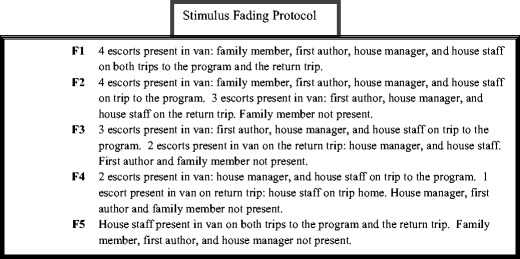Abstract
The following paper details the implementation of a program to address the high-risk physical aggression and property destruction behavior of an adult male with an autism spectrum disorder (ASD) and severe aggressive behavior. A task analysis (TA) and forward chaining were combined with a stimulus fading procedure to allow the subject to be able to participate in van rides when prompted with no displays of aggressive or self-injurious behavior. A follow-up probe completed at 1-year post intervention demonstrated the maintenance of the gains that were made during treatment.
Keywords: Fading, Autism, Non-compliance, Task analysis, Physical aggression, Self-injurious behavior
The teaching of complex skills that involve a number of steps is a challenge that faces those working with individuals with autism spectrum disorders (ASDs). The task is much more manageable when the complex behaviors are broken down into a series of steps that are taught individually. This forward chaining approach involves the first step in the task being taught followed by the succeeding steps (Cooper et al. 2007). An obstacle to completing the chain can be escape-maintained disruptive behavior. The use of effective chaining procedures can be combined with other behavioral techniques to facilitate learning despite significant aggression.
Avoidance responses have been treated using various behavioral procedures (Jones and Friman 1999; Shabani and Fisher 2006). These approaches have employed graduated exposure protocols or hierarchies in order to expose the subject to the avoided stimulus. The intent is to induce extinction of the avoidance response through the systematic presentation of the feared stimulus. Shabani and Fisher (2006) demonstrated this intervention when applied to the needle phobia of an 18 year old with an autism spectrum disorder. The results showed that he was able to tolerate the use of the lancet and to follow the steps that were required to draw his blood at the completion of the hierarchy. Similar results were found with a 35-year-old female that displayed a fear of riding in cars.
Operant techniques were used to treat the car avoidance displayed by a female subject (Mansdorf 1976). Verbal resistance and other aggressive behaviors were noted when the subject was told that she would have to ride in a car in order to go to a work program. A hierarchy was constructed consisting of a list of successive approximations that culminated in the subject taking progressively longer car rides with the experimenter.
The current study used similar operant procedures to treat the significant aggression of an adult with an autism spectrum disorder. The aggression was displayed whenever he was prompted to ride in a van to the day program that he was attending. The primary difference in this study is the severity of the aggressive behavior and the significant obstacle that this posed to safe transport in a van. Several staff and family members had received injuries as a result of the aggressive behavior displayed when the subject was prompted to get into the van.
A task analysis (TA) was used to construct a series of 10 steps for transporting Randy to his day program (Table 1). An ABAB withdrawal design was used to demonstrate experimental control (Fig. 1). During the baseline phase (A), Randy would not ride in the van but would exhibit physical aggression, self-injurious behavior, and property destruction. In the treatment phase (independent variable) (B) beginning at session 23, Randy was escorted in the van to his day program by four individuals (F1) with whom he was comfortable who were then faded to the point that only one staff was needed for the drive (F5). Randy did not attend his day program on sessions 31 through 41, but when he resumed on session 42, he rode in the van with just one staff member (step F5). Along with this favorable result, a number of relevant findings were encountered.
Table 1.
The task analysis that was implemented by staff every day upon initiating the client’s trip to the day program. Each separate step was checked off as it was accomplished

Fig. 1.

Compliance with TA in the program. Each of the steps from F1 through F5 was systematically faded until only step F5 was required
Randy was extremely aggressive in his initial refusal to get into the van during the baseline phase of the study. Once he was compliant with getting into the van, each of the various steps was faded. As we progressed further into the forward chaining procedure from steps 4 forward, his displays of refusal and aggression had decreased to zero.
Randy responded to the prompting hierarchy which was followed in the same order every day. The second baseline was initiated by an illness. Randy was unable to attend the program for 3 days due to an illness that started at session 31. When he recovered, he did not comply with the prompt to leave for the day program until the chaining procedure was reinstated.
The first step in the TA seemed to serve as a discriminative stimulus (SD) for each of the remaining steps in the sequence. In the absence of the first step in the chain, the subsequent SDs were no longer present and could have impacted responding in that way. Future studies could examine the use of portions of the TA or probe their effects as they are introduced in sequential fashion. Another finding of the current study was the manner in which the stimulus fading protocol was administered.
The fading protocol was not resumed from the beginning when the intervention was initiated the second time. Randy was compliant with getting into the van after all of the steps of the chaining procedure were completed and reinforced. This suggests that the controlling variable at this point may have been the successive steps in the behavioral chain. Randy’s compliance was achieved through the controlling variables of the chaining procedure and the discriminative stimuli (SDs) that were presented daily through each of the steps.
The presence of the additional staff in the van was not necessary as he indicated that he did not want them present. This demonstrates that, though he had refused to attend when the chaining procedure was not implemented, once it was, he had generalized the skill of safe van riding without the additional supports that were required initially.
The results of this study show that the combination of task analysis/chaining and prompt fading were effective in teaching a new behavior. However, one limitation of the study is that the contributions of each separate intervention were not able to be determined. Future studies could employ a component analysis to isolate the effect of each of the variables. Further analysis of some of the items on the task analysis, such as the usage of the communication board, could be investigated further related to their function of making the van rides more reinforcing.
Acknowledgments
Conflict of Interest
The authors declare that they have no conflict of interest.
Ethical Approval
“All procedures performed in studies involving human participants were in accordance with the ethical standards of the institutional and/or national research committee and with the 1964 Declaration of Helsinki and its later amendments or comparable ethical standards.”
Appendix
The study took place in a community-based home that was located in a residential neighborhood in a large Midwestern town. The residence was equipped with three bedrooms, two bathrooms, and separate kitchen and dining room areas. The residence was staffed 24 h a day, 7 days a week. The study was conducted in a company van that had adjacent driver and passenger-side seats, a second row of adjacent captain’s chairs seats, and an extended rear seat.
Randy was a 23-year-old male diagnosed with an autism spectrum disorder. The subject displayed high frequencies of aggressive behavior, property destruction, and self-injurious behavior that were so dangerous that an analogue functional analysis was not feasible. Systematic evaluation of the function of these behaviors was conducted via the functional assessment instruments the Questions about Behavioral Function (QABF) and Functional Assessment Screening Tool (FAST) (Iwata et al. 2013). These assessments indicated that his aggression served an escape function.
Intervention strategy—Prior to the study, Randy had lived with his mother for 22 years and had only traveled with family members in their vehicles. Therefore, the familiar stimuli of his mother, the first author, and the house manager were utilized to make the van ride less aversive and were faded out as the program progressed.
Additionally, Randy wore a weighted vest that was previously introduced by previous team members and encouraged by family members. It was retained due to his routine of wearing it prior to vehicle rides with his family. He displayed no resistance to wearing the vest when prompted.
Structure was added with a 10-step task analysis (TA) that was constructed and validated by the first author. Each step was forward chained and reinforced with his viewing a preferred video once he performed the terminal step of walking into the building where the day program was located. The initial prompt was the SD to follow the steps of the TA with each successive step an SD for the next step.
The dependent measure was the percentage of successful van trips, defined as the number of completed steps on the TA for van travel (see Table 1). Each of the steps of the TA was scored based on their occurrence or nonoccurrence for a given day. The same staff member initiated the prompting sequence and scored the TA data sheet each day. The first author was present during each of the steps of the fading procedure and scored the steps along with the staff member that had initiated the prompting sequence. Reliability data were taken for 100 % of the sessions utilizing the fading protocol, 30 % of the withdrawal phase, and 30 % of the subsequent sessions. Reliability ranged from 90 to 100 % with an average agreement score of 97 %. Inter-observer reliability was calculated utilizing the following formula:
An ABAB withdrawal design was used to demonstrate the efficacy of the treatment package employed in the study. A specific prompting sequence was followed whereby Randy was prompted to get ready to attend his day program during all of the phases of the study. During the stimulus fading and chaining conditions, the TA was scored and staff were trained on the implementation of each of the steps of the behavioral chain of getting ready for the day program as outlined in the TA.
A prompting sequence was initiated with Randy that involved an initial verbal prompt, “Randy, get up, it is time to go to the day program.” This verbal prompt was repeated if he did not respond within 30 s to the initial prompt. This sequence continued for 15 min until he either refused to participate or complied. The same prompting sequence was provided during all of the sessions during baseline. The prompts were repeated if he refused, but there were no other consequences that were provided after the provision of the verbal prompts. Refusal to attend or comply were treated the same in terms of staff’s response.
Fading protocol—The staff initiated the same verbal prompting sequence as described in the baseline phase on each day that the intervention was in place. The forward chaining procedure (see Table 1) was followed with each step in the TA being scored and subsequent steps being initiated as soon as the prior step had been accomplished. The primary difference that took place was the inclusion of familiar stimuli in the form of his mother and the first author. Both of these individuals assisted with the prompting and rode with him in the van once he was able to tolerate that portion of the chaining procedure. Once Randy was in the van, he was seated with the same seating configuration daily as outlined in the fading protocol (see Fig. 2). The staff that were present in the van were faded on successive days as he was transported to the site of his day program (see Fig. 2).
Fig. 2.

Each of the steps of the hierarchy was faded on successive days as indicated by the individual steps outlined above. Each of the steps from F1 through F5 was systematically faded on a daily basis until only step F5 was being followed on a daily basis
The return to baseline phase was identical to the baseline phase described above. The same staff member was identified to initiate the prompting sequence. The staff member did not utilize the chaining procedure described above. Randy was given a verbal prompt to prepare to get up and get ready to go to his day program. The prompts were repeated if he refused according to the same schedule as described in the initial baseline phase, but there were no other consequences that were provided after the provision of the verbal prompts. Refusal to attend and comply were treated the same in terms of staff’s response to his compliance or refusal to participate.
The follow-up phase was identical to the baseline phase described above. The same staff member was identified to initiate the prompting sequence. The prompts were repeated if he refused according to the same schedule described in the initial baseline phase, but there were no other consequences that were provided after the provision of the verbal prompts.
Footnotes
Severe aggression in an adult with ASD was addressed by breaking down the daily routine into smaller parts using chaining and fading.
Indirect assessment procedures were employed due to the participant’s behavior being too dangerous to conduct an analogue functional analysis.
Caregivers were actively engaged in the intervention, along with service providers.
A reduction in behavior problems allowed for increased engagement in work.
References
- Cooper JO, Heron TE, Heward WL. Applied behavior analysis. 2. Upper Saddle River: Pearson Education Inc.; 2007. [Google Scholar]
- Iwata BA, DeLeon IG, Roscoe EM. Reliability and validity of the functional analysis screening tool. Journal of Applied Behavior Analysis. 2013;46:271–284. doi: 10.1002/jaba.31. [DOI] [PubMed] [Google Scholar]
- Jones KM, Friman PC. A case study of behavioral assessment and treatment of insect phobia. The Journal of Applied Behavior Analysis. 1999;32:95–98. doi: 10.1901/jaba.1999.32-95. [DOI] [PMC free article] [PubMed] [Google Scholar]
- Mansdorf IJ. Eliminating fear in a mentally retarded adult by behavioral hierarchies and operant techniques. Journal of Behavior Therapy and Experimental Psychiatry. 1976;7:189–190. doi: 10.1016/0005-7916(76)90083-5. [DOI] [Google Scholar]
- Shabani DB, Fisher WW. Stimulus fading and differential reinforcement for the treatment of needle phobia in a youth with autism. The Journal of Applied Behavior Analysis. 2006;39(4):449–452. doi: 10.1901/jaba.2006.30-05. [DOI] [PMC free article] [PubMed] [Google Scholar]


